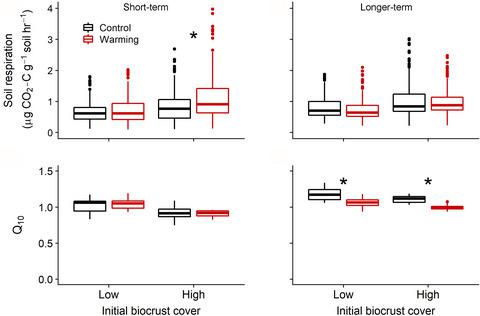当前位置:
X-MOL 学术
›
Glob. Change Biol.
›
论文详情
Our official English website, www.x-mol.net, welcomes your
feedback! (Note: you will need to create a separate account there.)
Contrasting mechanisms underlie short- and longer-term soil respiration responses to experimental warming in a dryland ecosystem.
Global Change Biology ( IF 10.8 ) Pub Date : 2020-06-08 , DOI: 10.1111/gcb.15209 Marina Dacal 1, 2 , Pablo García-Palacios 3 , Sergio Asensio 2 , Concha Cano-Díaz 1 , Beatriz Gozalo 2 , Victoria Ochoa 2 , Fernando T Maestre 2, 4
Global Change Biology ( IF 10.8 ) Pub Date : 2020-06-08 , DOI: 10.1111/gcb.15209 Marina Dacal 1, 2 , Pablo García-Palacios 3 , Sergio Asensio 2 , Concha Cano-Díaz 1 , Beatriz Gozalo 2 , Victoria Ochoa 2 , Fernando T Maestre 2, 4
Affiliation

|
Soil carbon losses to the atmosphere through soil respiration are expected to rise with ongoing temperature increases, but available evidence from mesic biomes suggests that such response disappears after a few years of experimental warming. However, there is lack of empirical basis for these temporal dynamics in soil respiration responses, and for the mechanisms underlying them, in drylands, which collectively form the largest biome on Earth and store 32% of the global soil organic carbon pool. We coupled data from a 10 year warming experiment in a biocrust‐dominated dryland ecosystem with laboratory incubations to confront 0–2 years (short‐term hereafter) versus 8–10 years (longer‐term hereafter) soil respiration responses to warming. Our results showed that increased soil respiration rates with short‐term warming observed in areas with high biocrust cover returned to control levels in the longer‐term. Warming‐induced increases in soil temperature were the main drivers of the short‐term soil respiration responses, whereas longer‐term soil respiration responses to warming were primarily driven by thermal acclimation and warming‐induced reductions in biocrust cover. Our results highlight the importance of evaluating short‐ and longer‐term soil respiration responses to warming as a mean to reduce the uncertainty in predicting the soil carbon–climate feedback in drylands.
中文翻译:

在干旱地区生态系统中,相对机制是短期和长期土壤呼吸对实验性变暖的响应。
预计随着土壤温度的升高,通过土壤呼吸作用向大气中的土壤碳损失会增加,但是中生生物群落的现有证据表明,这种反应在经过几年的实验变暖后就消失了。然而,在土壤呼吸反应中的这些时间动态及其背后的机制方面,缺乏经验依据,在干旱地区,干旱地区共同构成了地球上最大的生物群落,并存储了全球土壤有机碳库的32%。我们将在以生物壳为主的旱地生态系统中进行为期10年的变暖实验的数据与实验室孵化相结合,以应对土壤对变暖的呼吸响应0–2年(此后为短期)和8–10年(此后为长期)。我们的结果表明,在生物结皮覆盖率较高的地区,随着短期变暖,土壤呼吸速率会长期恢复到控制水平。升温引起的土壤温度升高是短期土壤呼吸响应的主要驱动力,而长期升温对土壤呼吸的响应主要由热适应和升温导致的生物结皮减少所驱动。我们的结果突显了评估短期和长期土壤变暖对变暖的重要性,以此来减少预测旱地土壤碳-气候反馈时的不确定性。而长期的土壤呼吸对变暖的响应主要是由热适应和变暖导致的生物结皮减少所驱动。我们的结果突显了评估短期和长期土壤变暖对变暖的重要性,以此来减少预测旱地土壤碳-气候反馈时的不确定性。而长期土壤呼吸对变暖的响应主要是由热适应和变暖引起的生物结皮减少所驱动。我们的结果强调了评估短期和长期土壤呼吸对变暖的重要性,以减少预测旱地土壤碳-气候反馈的不确定性。
更新日期:2020-08-11
中文翻译:

在干旱地区生态系统中,相对机制是短期和长期土壤呼吸对实验性变暖的响应。
预计随着土壤温度的升高,通过土壤呼吸作用向大气中的土壤碳损失会增加,但是中生生物群落的现有证据表明,这种反应在经过几年的实验变暖后就消失了。然而,在土壤呼吸反应中的这些时间动态及其背后的机制方面,缺乏经验依据,在干旱地区,干旱地区共同构成了地球上最大的生物群落,并存储了全球土壤有机碳库的32%。我们将在以生物壳为主的旱地生态系统中进行为期10年的变暖实验的数据与实验室孵化相结合,以应对土壤对变暖的呼吸响应0–2年(此后为短期)和8–10年(此后为长期)。我们的结果表明,在生物结皮覆盖率较高的地区,随着短期变暖,土壤呼吸速率会长期恢复到控制水平。升温引起的土壤温度升高是短期土壤呼吸响应的主要驱动力,而长期升温对土壤呼吸的响应主要由热适应和升温导致的生物结皮减少所驱动。我们的结果突显了评估短期和长期土壤变暖对变暖的重要性,以此来减少预测旱地土壤碳-气候反馈时的不确定性。而长期的土壤呼吸对变暖的响应主要是由热适应和变暖导致的生物结皮减少所驱动。我们的结果突显了评估短期和长期土壤变暖对变暖的重要性,以此来减少预测旱地土壤碳-气候反馈时的不确定性。而长期土壤呼吸对变暖的响应主要是由热适应和变暖引起的生物结皮减少所驱动。我们的结果强调了评估短期和长期土壤呼吸对变暖的重要性,以减少预测旱地土壤碳-气候反馈的不确定性。











































 京公网安备 11010802027423号
京公网安备 11010802027423号